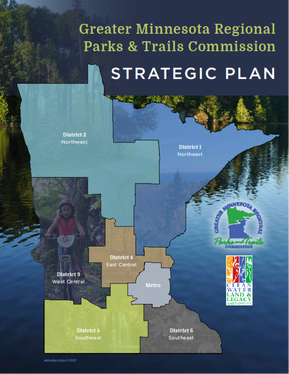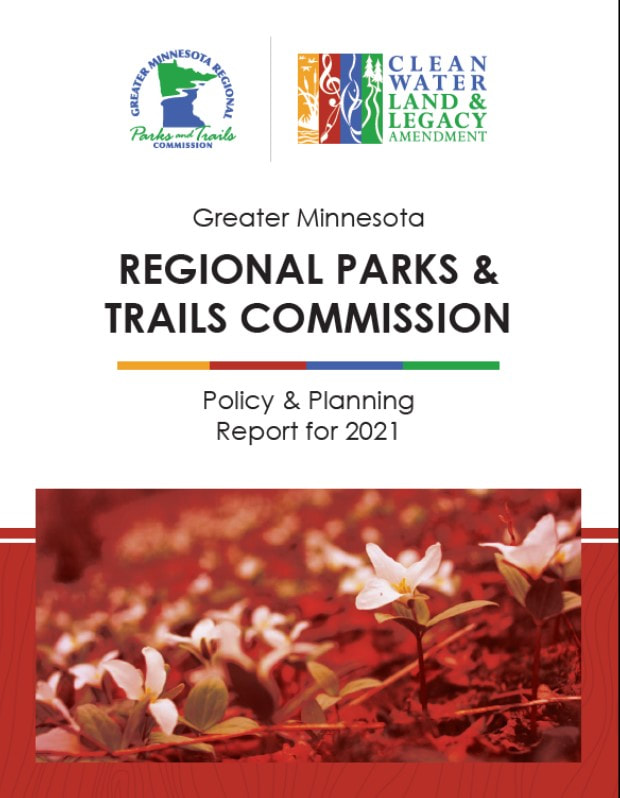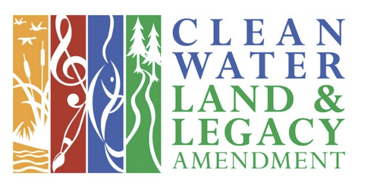|
In June 2020 the Parks and Trails Legacy Partners embarked on a two-year research project to count visitors to the three system’s parks and trails. Coordination Among Partners funds have paid for this research project for the benefit of all. A data scientist was hired and is housed at the Metropolitan Council offices, working with support of their research team.
The scope of the project is to conduct a statewide analysis of parks and trails visitation, which for Greater Minnesota includes not only designated parks, but parks ranked “eligible for designation” as well. The data used for the research has come from StreetLight Data, Inc., a company that aggregates vast amounts of anonymized data gathered from cell phones to algorithmically transform the inputs into contextualized, aggregated and normalized travel patterns. In plain speaking, they can deliver insight into how vehicles, bikes, pedestrians and transit passengers move on virtually every road and in every Census Block. This information provides the data scientists with ways to count visitors to our system parks and trails. Information that in many parks and trails in Greater Minnesota, we simply do not have. While the date shows as May 13, 2022, the information has been updated as StreetLight Data has advanced with a recent algorithm update. Please know that the system park information study is complete, but trail research is still underway and will be released in the first quarter of 2023. We invite you to review the report, check park visitation for your park or against other parks in the Greater Minnesota system or our partner agencies; Metropolitan Council Regional Parks and DNR State Parks.
The Greater Minnesota Regional Parks and Trails Commission coordinated a survey of three mountain bike systems in Greater Minnesota during the summer of 2021. The Parks and Trails Council of Minnesota was hired to conduct a visitor intercept survey and trail user counts at the Cook County Mountain Bike Trails, Duluth Traverse, and Detroit Mountain Recreation Area.
In this report you will find detailed information about the user counts and the visitor profiles for each system. The report begins with a trail county summary that provides a starting point to understand the unique differences and the similarities of the average daily traffic. If you have questions or comments, please contact Renee Mattson, Executive Director at [email protected], or Joe Czapiewski, System Plan Coordinator at [email protected]. 2021 Mountain Bike System Survey Cover Letter 2021 Trail Count Summary Duluth Topline Report Duluth Traverse Visitor Profile 2021 Cook County Topline Report Cook County Visitor Profile 2021 Detroit Mountain Topline Report Detroit Mountain Visitor Profile 2021
The Greater Minnesota Regional Parks and Trails Commission has released its 2021 Policy and Planning Legislative Report. The report includes a review of the Legacy grant recommendations for the Fiscal Year 2023 funding cycle, the criteria and selection process used, as well as an overview of Greater Minnesota's regional system development.
The Commission received 20 eligible funding applications and were able to fund, in whole or in part, all 20 applications! With a $1,860,396 budget make-up due to COVID budget reductions in FY22, the Commission had an unprecedented $12,201,546 to award. Additionally, $212,053 was placed in a Connecting People with the Outdoors Small Grant Fund that will be used to fund programming, accessibility, and other CPO initiatives that may be modeled as prototype projects in other communities. Review the full 2021 Policy and Planning Report HERE.
The Metropolitan Council Regional Parks agency undertook a research study to better understand and provide for the outdoor recreational needs and preferences of young people. After noting that youth engagement has been dropping since the 1990's, the Agency understood that connecting youth to the outdoors is essential to achieve the equitable outcomes required in the Met Council's 2040 Regional Parks Policy Plan.
This report includes an overview of how they collaborated to engage youth, what engagement techniques worked and what didn't, and the key findings of their research. The GMRPTC encourages effective public engagement that builds equitable use among all Minnesotans. Youth & Parks: Getting Outdoors Close to Home
The US Department of Transportation has released a "Lessons Learned" report updating its experience supporting rail to trail conversion projects over the past 20+ years. The report attempts to capture best practices by addressing common concerns, challenges and factors to consider before, during, and after rail to trail projects.
A summary and full report can be found at https://www.fhwa.dot.gov/environment/recreational_trails/publications/rwt2021/. The Rails to Trails Conservancy also has provided a summary article at https://www.railstotrails.org/trailblog/2021/june/25/new-usdot-report-provides-25-years-of-lessons-learned-for-rails-with-trails/?utm_source=linkedin&utm_medium=social&utm_campaign=trailblog. 
For additional information, contact System Plan Coordinator Joe Czapiewski at [email protected] or Executive Director Renee Mattson at [email protected].
(May 13, 2021 – DULUTH, Minn.) – An updated strategic plan for guiding future development of Greater Minnesota’s regional parks and trails, including ensuring those areas are inviting and accessible to underserved communities, is now available to the public from the Greater Minnesota Regional Parks and Trails Commission (GMRPTC). Established in 2013, the Commission identifies regionally significant parks and trails in Minnesota’s 80 counties outside the seven-county metropolitan area and provides grant recommendations to the State Legislature. Funding comes from the Parks and Trails Legacy Fund, part of the Clean Water Land and Legacy Amendment approved by state voters in 2008. “Many people have worked hard to build a system of regional parks and trails that all Minnesotans can be proud of,” said GMRPTC Board Chair Thomas Ryan, adding that to date the organization has designated 64 parks and trails as regionally significant. “This updated strategic plan ensures we have consistent, detailed criteria for creating a seamless outdoor recreation system that integrates with those of our partners at the Department of Natural Resources and Metropolitan Council Regional Parks.” This 86-page plan, filled with photos, maps and graphs, is designed to help local parks and trails agencies around Greater Minnesota develop effective proposals for regional designation and funding. As more agencies prepare their initial or updated Master Plans, they can look to this strategic plan for clearer standards and tools that will help tell their regional story. The plan includes criteria for making parks and trails inviting and accessible to underserved communities and people with mobility or other challenges, identifies new ways of monitoring and measuring success, and more. The entire strategic plan may be found at www.gmrptcommission.org. Citizens may also ask to have a printed version mailed to them by contacting GMRPTC Executive Director Renee Mattson at [email protected]. “Achieving designation requires an applicant to work through a detailed process that ensures each park or trail is of the quality Minnesotans and visitors expect when enjoying regionally significant facilities. The strategic plan provides guidance to help applicants think broadly and boldly about not only what the facility is now, but what it could be,” said Mattson. She added that the GMRPTC will hold a series of online workshops in June to help agencies understand the new plan’s contents. Information about workshop times and dates is at https://www.gmrptcommission.org/2021-district-workshops.html. Since its inception, the GMRPTC has awarded more than $52 million in grants to regional parks and trails across Greater Minnesota. Combined with $20 million in community investments, grants are used to fund infrastructure improvements, land acquisitions, new facilities, trail rehabilitation and more.
The Greater Minnesota Regional Parks and Trails Commission has announced grant recommendations for the FY2022 funding cycle.
Of the 64 regionally designated parks and trails in the Greater Minnesota system, the Commission received 14 applications and selected 11 projects totaling $7,755,429 to recommend for legislative approval. See the full press release and recommendation list below. Learn more about how the Commission is working with other cities and counties in all six Greater Minnesota districts to fulfill the 25-year Legacy Plan in the attached annual Policy and Planning report to the Legislature.
By Joe Czapiewski, AICP
System Plan Coordinator Greater Minnesota Regional Parks and Trails Commission Republished from the April-June 2020 issue of Planning Minnesota What would you do if you had to create a new state agency from scratch? That’s essentially what the 13 governor-appointed members of the Greater Minnesota Regional Parks and Trails Commission (GMRPTC) set out to do in October 2013. Armed with enabling legislation, the possibility of distributing a portion of the Clean Water, Land and Legacy Amendment funding, and a brand-new strategic plan, the volunteer Commission got to work improving outdoor recreation across Greater Minnesota. Notice I said the “possibility” of distributing Legacy Amendment funding. While the sales tax funding was available quickly, the brand-new Commission wasn’t ready to manage it. The Commission is one leg of a three-legged stool also consisting of the Minnesota Department of Natural Resources and the Metropolitan Council’s Regional Parks and Natural Resources Department. Each agency is responsible for managing a portion of the Legacy Amendment’s sales tax revenue dedicated to parks and trails. As a new entity, the Commission had to prove not only the viability of its concept, but the capacity of the organization as well. Until then, distribution and management of its portion of funding was in the hands of the DNR. Let’s take a look at how the Commission tackled this challenge. Who, How and Why The Commission’s role is to “undertake system planning and provide recommendations to the legislature for grants funded by the parks and trails fund to counties and cities outside of the seven-county metropolitan area for parks and trails of regional significance (Mn Statute 85.536).” There’s a lot packed in there, so let’s break down three critical parts. The first part is “who”. The GMRPTC is targeted toward Greater Minnesota’s public (city and county) parks and trails of regional significance. What does that mean? Well, the Commission’s Strategic Plan contains criteria for facilities that rise to the level of designation as a part of the regional system. If you meet the criteria, you’re in! How do you know if you meet the criteria? The Strategic Plan is a policy plan guiding the development of the overall regional system. It lays out the application process, the criteria, and the requirements for submitting a qualified Unit Master Plan. The Commission has never been shy about holding a high standard for the facilities that want to be a part of the system. Achieving designation is the most significant part of the overall process, receiving the most scrutiny. Once you are designated a part of the system, applying for funding is fairly straightforward. It doesn’t mean that there aren’t standards, criteria, and competition, but the applicant pool is fairly small and your chances of success at this point are much better than many other statewide programs. Funding applications are also relatively simple, compared to Master Plan creation and evaluation. In the end, receiving funding is the carrot to encourage good planning! Planning is Key System planning from scratch was the challenge, and the opportunity, for the Commission. To build a system worthy of funding, we needed to recruit cities and counties with park and trail concepts that were worthy of the title “regionally significant” and receiving state funds. There were also no funds to directly support Unit Master Plan development by cities and counties, which fostered creativity in how the Commission supported applicants. It would have been easy to designate a bunch of low hanging fruit, in the form of several well-known and developed parks and trails, and call it good. Instead, the Commission knew it could leverage its process and funds to raise the bar for park and trail planning across Greater Minnesota. The key to doing that was to link system designation to creation of a “qualified” Master Plan. Planning requirements encourage professional standards, linkage between facility concepts and public demand, and a certain level of planning for construction costs, maintenance, and operations. It also allowed the Commission to evaluate unbuilt concepts, not just existing facilities that had already been successful acquiring resources. Outside of a few major cities and counties in Greater Minnesota, most local jurisdictions had never done this kind of park planning work. Few of them had dedicated recreation staff, funding for planning, or experience. How could we ensure equity and cost effectiveness across the state while quickly building a quality system? The answer was to use technology and a local presence (built relatively cheaply) to educate and support all potential applicants. Here are a few of the tools we used: Working with People
Leveraging Technology
We also like to point out that the Master Plan portal in the DMS is free and open for everyone at www.gmrptcommission.org/applications.html. Even if you don’t plan to apply for designation, feel free to ask your planner to complete the Master Plan in the portal. It can help ensure a higher standard of development and reduce production expenses.
Success to Date While this system isn’t perfect, the Commission has found success in achieving its goals for park and trail planning. There are currently 62 facilities in the regional system, built from hundreds of applicants in all corners of the state. The Strategic Plan continues to evolve – a new version will be released this summer that streamlines criteria, evolves the Commission’s public engagement process and further raises the bar for Unit Master Plans. We have learned that more work is needed in the areas of park programming, marketing, and long-term maintenance and operations planning, so updated standards and education will reflect that. The Commission also achieved its goal of managing its own funding selection process as of 2015. That’s only two years from building a system from scratch to overseeing the investment of approximately $9,000,000 per year. We have been fortunate to have great partners at the DNR and Metropolitan Council Parks Department who support the Commission’s work and take our place at the table with them seriously. Together, we are building a fantastic system of parks and trails for all Minnesotans and visitors to enjoy! To learn more about our application, system, and organization, visit the Commission’s website at www.gmrptcommission.org. You can also follow us on Facebook, Twitter (@gmrptc) and Instagram (@greaterminnesota) for news updates and explorations of the great parks and trails across Greater Minnesota!
On Wednesday Governor Walz announced new guidance for the reopening and use of campgrounds in Minnesota, starting June 1. Find them on the DNR's website HERE.
The Greater Minnesota Regional Parks and Trails Commission worked with many agencies around the state including DNR, National Forest Service, Metro Parks, Greater Minnesota Parks and Trails, and more to help create these campground guidelines. They are intended to help you determine the minimum standards that you should be implementing while you work to open your campgrounds but allow for room to do more if you have the proper staffing and ability to maintain best practices. We hope everyone is doing well and making safe use of Minnesota's great outdoor spaces this summer!
The Greater Minnesota Regional Parks and Trails Commission has published its annual Policy and Planning report to the Legislature.
This annual report highlights the growth and impact of Greater Minnesota's regional system of parks and trails. Supported by the Clean Water and Legacy Amendment, sixty-two facilities across 80 counties provide a wide variety of outdoor recreation opportunities for residents and visitors. Learn more about how the Commission is working with cities and counties in all six Greater Minnesota districts to fulfill the 25-year Legacy Plan. |
Categories
All
Archives
June 2024
Subscribe to
receive blog posts in your email. |
||||||||||||||||||||||||
|
Questions? Contact [email protected]
© 2023 Greater Minnesota Regional Parks and Trails Commission. All Rights Reserved. |



 RSS Feed
RSS Feed
